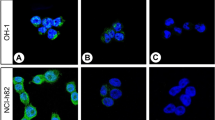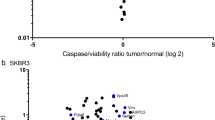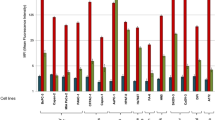Abstract
RAP-5, a monoclonal antibody raised against a p21ras peptide, has been claimed to show immunohistochemical localisation of cells with infiltrative properties in human tumours. We confirmed that this antibody reveals pronounced cellular heterogeneity in human colonic neoplasms but could find no obvious relationship to infiltrative activity. RAP-5 bound to many different cell types, neoplastic and normal. In order to clarify the specificities of RAP-5 we applied it to two cell lines: nontumorigenic hamster fibroblasts in which ras expression is barely detectable, and a vigorously tumorigenic line derived from these fibroblasts by insertion of the human mutated Ha-ras oncogene in a high expression vector. Another antibody to p21ras, Y13-259, clearly distinguished between these cell lines both on immunoblots and immunocytochemically, but RAP-5 did not. Rather, it bound to proteins of a variety of molecular weights in both cell lines. The results show that RAP-5 is unlikely to be a useful reagent for detection of ras associated proteins in human tissues.
This is a preview of subscription content, access via your institution
Access options
Subscribe to this journal
Receive 24 print issues and online access
$259.00 per year
only $10.79 per issue
Buy this article
- Purchase on SpringerLink
- Instant access to full article PDF
Prices may be subject to local taxes which are calculated during checkout
Similar content being viewed by others
Rights and permissions
About this article
Cite this article
Robinson, A., Williams, A., Piris, J. et al. Evaluation of a monoclonal antibody to ras peptide, RAP-5, claimed to bind preferentially to cells of infiltrating carcinomas. Br J Cancer 54, 877–883 (1986). https://doi.org/10.1038/bjc.1986.256
Issue Date:
DOI: https://doi.org/10.1038/bjc.1986.256
This article is cited by
-
Quantitation of mRNA and protein products of the Ha-ras-1 proto-oncogene
Breast Cancer Research and Treatment (1990)
-
Detection of rat gene alterations and ras proteins in colorectal cancer
Diseases of the Colon & Rectum (1989)
-
Immunocytochemical localization ofras p21 product in thyroid follicular cells of normal rats using monoclonal antibody RAP-5
The Histochemical Journal (1988)
-
Enhanced expression of ras gene products in psoriatic epidermis
Archives of Dermatological Research (1988)



